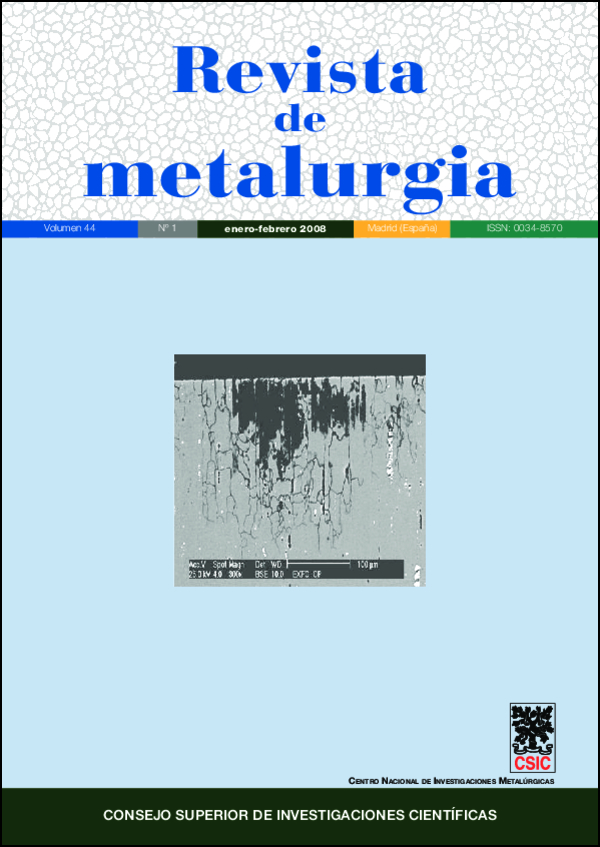Development of an artificial lock for the skin-pass section in a hot dip
DOI:
https://doi.org/10.3989/revmetalm.2008.v44.i1.93Keywords:
Hot dip galvanised steel, Skin-pass, Data mining, Neural networks, Artificial lockAbstract
In this paper, we present the application of data mining techniques to develop an “artificial lock” for the skin-pass in an attempt to solve a problem that can arise during the galvanising manufacturing process: the wrong labelling of the steel grade of a coil. In order to detect these errors and thus to avoid that coils with different properties than expected end up with a client, we propose neural network-based models for on-line predicting the strip elongation in the skin-pass section according to the manufacturing conditions and its chemical composition. Thus, a significant difference between estimated and measured elongation would mean that the coil must be removed from the line for further analyses.
Downloads
References
[1] J.B. Ordieres-Meré, A. González-Marcos, J.A. González y V. Lobato-Rubio, Ironmaking Steelmaking 31 (2004) 43-50. doi:10.1179/030192304225012060
[2] A.V. Pernía-Espinoza, M. Castejón-Limas, A. González-Marcos y V. Lobato-Rubio, Ironmaking Steelmaking 32 (2005) 418-426. doi:10.1179/174328105X28829
[3] P. Chapman, J. Clinton, R. Kerber, T. Khabaza, R. Reinartz, C. Shearer y R. Wirth, CRISP-DM 1.0: Step-by-step data mining guide, CRISP-DM consortium / SPSS Inc., 2000.
[4] D. Pyle, Data Preparation for Data Mining, Morgan Kaufmann Publishers, San Francisco, EE.UU., 1999, pp. 9-44.
[5] R.J. Brachman y T. Anand, Advances in knowledge discovery and data mining, U. Fayyad, G. Piatetsky-Shapiro, P. Smyth y R. Uthurusamy (Eds.), AAAI Press/The MIT Press, Menlo Park, CA, EE.UU., 1996, pp. 37-57.
[6] U. Fayyad, G. Piatetsky-Shapiro y P. Smyth, Proc. KDD-96, Portland, Oregon, 1996, E. Simoudis, J. Han y U. Fayyad (Eds.), AAAI Press, Menlo Park, CA, EE.UU., 1996, pp. 82-88.
[7] R. Bellman, Adaptive Control Processes: A Guided Tour, Princeton University Press, New Jersey, EE.UU., 1961.
[8] M. Castejón-Limas, J.B. Ordieres-Meré, F.J. Martínez De Pisón-Ascacíbar y E. Vergara-González, Data Min. Knowl. Disc. 9 (2004) 171-187. doi:10.1023/B:DAMI.0000031630.50685.7c
[9] G.J. Mclachlan, Discriminant analysis and statistical pattern recognition, John Wiley & Sons, New York, EE.UU., 1992.
[10] K. Funahashi, Neural Netw. 2 (1989) 183-192. doi:10.1016/0893-6080(89)90003-8
[11] K. Hornik, M. Stinchcombe Y H. White, Neural Networks 2 (1989) 359-366. doi:10.1016/0893-6080(89)90020-8
[12] S. Haykin, Neural networks, a comprehensive foundation, Prentice Hall, 2ª ed., New Jersey, EE.UU., 1999, pp. 146-255.
[13] http://www.r-project.org. The R Project for Statical Computing.
[14] http://www-ra.informatik.uni-tuebingen.de/dowloans/. Institute for parallel and distributed high performance systems. SNNS-Stutgart Neural Network Simulator.
Downloads
Published
How to Cite
Issue
Section
License
Copyright (c) 2008 Consejo Superior de Investigaciones Científicas (CSIC)

This work is licensed under a Creative Commons Attribution 4.0 International License.
© CSIC. Manuscripts published in both the printed and online versions of this Journal are the property of Consejo Superior de Investigaciones Científicas, and quoting this source is a requirement for any partial or full reproduction.
All contents of this electronic edition, except where otherwise noted, are distributed under a “Creative Commons Attribution 4.0 International” (CC BY 4.0) License. You may read the basic information and the legal text of the license. The indication of the CC BY 4.0 License must be expressly stated in this way when necessary.
Self-archiving in repositories, personal webpages or similar, of any version other than the published by the Editor, is not allowed.
















